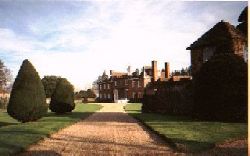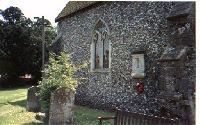THE ORIGINS OF THE DE LAUNE CYCLING
CLUB
The history of the Club is entwined with the old Kentish
village of Newnham and if you visit the local church you will observe a Plaque
on the left hand side of the main entrance door. I expect you may be wondering
why a London based cycling club has connections with the Newnham church.
To answer that we must go back to the year 1582. That was
the year when a French Huguenot physician and cleric, William Delaune, fled with
his family to England. In 1625 one of his two sons, Gideon, who had accumulated
great wealth as apothecary to Queen Anne, bought Sharsted Court for his son
Abraham.
Sharsted Court dates from the early 14th Century and
remained in the De Laune family for more than 300 years. It started as a
medieval manor house and was transformed into a Queen Anne mansion by Colonel
William Delaune in 1711. The house was once described as "ancient,
romantic, rambling.... set among furlongs of topiary and acres of beech wood on
the Down land plateau some seven miles southwards of Faversham and
Sittingbourne." It was also pointed out that it was an inconvenient place
to live; having many rooms, twisting passages and no less than seventeen
staircases. One bedroom is said to be haunted and there are stories of
terrifying shrieks, guttering candles and a hideous figure. One footman who went
to investigate the commotion returned in coherent and died shortly after.
The main feature of Sharsted Court was not it fact the
ghost, but the topiary garden - an extraordinary display of geometrically shaped
yew trees. The garden was developed, during the second half of the nineteenth
century, by the man who was to weave together the strands of history which
brought the De Laune Cycling Club into being: Mr. Chapman Delaune Faunce-De
Laune. He inherited Sharsted from his father, Captain Edmund Faunce whose family
ancestors came over with William the Conqueror. The Faunces and the Delaunes
were linked through marriage - and Mr. Chapman Delaune Faunce strengthened that
link by adding "De Laune" (spelt as two words) to his surname.
Mr. De Laune was a man of some substance - a High Sheriff
of Kent, a magistrate and a considerable landowner. Much of his property was in
South London (De Laune Street and Faunce Street are still there) so it was only
natural that the parish priest of St. Mary's, Newington, should turn to him for
help when he wanted to set up a social club for young men. Mr. De Laune did more
than just help - he gave No.22 New Street, Kennington, for the young men's
exclusive use. He also paid for the building of a gymnasium, dressing room and
other improvements. Thus the De Laune Institute was started.
He himself became the President of the Institute and
actively encouraged the wide-ranging sporting interests of Victorian England.
These included cricket, billiards, boxing, football, gymnastics, dramatics,
athletics, debating, singing and dancing. In the summer of 1888 a few of the
members organised a number of cycle rides. Such was their enjoyment that they
used the winter to canvas further support and in the spring of 1889 the De Laune
Institute Cycling Club was founded. The forerunner of the De Laune Cycling Club;
which these days are based in Peck ham, south London. Our connections with the
family lasted for many years. Mr. Alured Faunce De Laune was President from 1909
to 1949; his wife Margaret then held the Presidency from 1949 until 1956.
During the Great War of 1914-18 Mrs Margaret Faunce De
Laune sent many personal gifts to our members serving in the Forces. After the
war, at a reunion dinner and concert, the Club presented her with a gold badge
of honour as a "thank you". At the same time the question of how best
to remember those who were killed in action was resolved when a member suggested
a memorial plaque. Another member carved the five names into a stone tablet;
this is positioned on the outside wall of the church. Captain De Laune duly
unveiled the plaque on Easter Day 1920. The nine members who were killed in the
Second World War were later added.
Although there are no club records of services having been
held between 1921 and 1928, we feel certain there must have been since the
horrors of the war would have been very prominent in people's minds. We are,
however, certain that from 1929 to the present time our club has made an annual
pilgrimage to Newnham to honour the memory of those fourteen young men.
In the Nineteen-Fifties Sharsted Court passed from the
hands of the De Laune family. The Institute where the club started, No.22 New
Street, Newington has long since been demolished. But, that little spark that
was ignited there one hundred and twelve years ago continues to burn bright.
For a deeper
understanding and an insight into the De Laune CC why not read
“A
Century Awheel” –
the first 0ne hundred years of the club.
